“What is the best time to visit Alaska?” or “What is the best time to cruise Alaska?” These are among the most common questions we receive, and indeed an important consideration when planning Alaska travel.
But the answer isn’t so simple. Thankfully, our experts have compiled all our tips here so you can see the benefits of each month as they might pertain to your needs. Start thinking about your own best time to go to Alaska, then make it happen with our trips that focus on wildlife and wilderness.
IN THIS POST – Best Time to Visit Alaska:
Month by Month:
– Apr, May, Jun, Jul, Aug, Sep, Oct, Nov, Winter
Best Time to Cruise Alaska
Best Time to Travel to Alaska by Land
Alaska Whale Watching Season
Alaska Mosquito Season
Alaska Weather & Packing
Alaska Climate Tables
More Resources
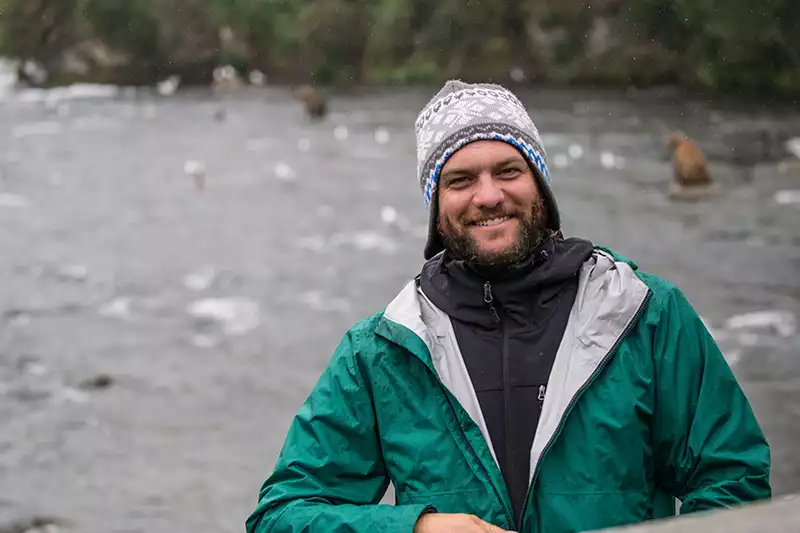
IN THE KNOW
ON WHEN TO GO
Expert insights,
delivered to your inbox.
A Primer on Alaska by Month: When to Go & Why
Alaska is huge and weather is vastly different in the north vs south or interior vs coast. And while the primary Alaska travel season is short, conditions can vary greatly between spring, summer and fall. Combine all this with Alaska’s notoriously unpredictable weather, and it can be a challenge to determine a single best time to visit Alaska.
That’s where our experts come in. The guide below is one piece of the puzzle to help you determine the best month to visit Alaska. We outline Alaska weather by month and answer questions such as “When is summer in Alaska?” and “What month is the best time to visit Alaska?” or “When is the best time to go to Alaska?” But our firsthand experience and one-on-one conversations can fill in the gaps. So don’t hesitate to contact us.
Note that in the guide below you’ll see us referring to Coastal, Interior and Arctic regions:
- The coastal region includes Southeast Alaska and the Alaska Inside Passage and Glacier Bay, Southcentral Alaska including Prince William Sound, Anchorage, Kodiak Island, as well as coastal Katmai National Park and the Aleutian Islands.
- Interior Alaska is the region north of Anchorage up to the Brooks Range just north of Fairbanks and includes Denali National Park.
- Arctic Alaska includes the Brooks Range north to the Arctic Ocean.
And while, of course, Alaska is open for travel year-round, the primary tourist season begins in June and ends in August. But our Alaska by month travel season calendar below starts in early spring, because that is when the cruising season kicks off in some of Alaska’s lower, warmer latitudes.
We hope this guide helps you make the most of your Alaska summer vacation. For even more information and detailed climate tables, view our Alaska climate page.
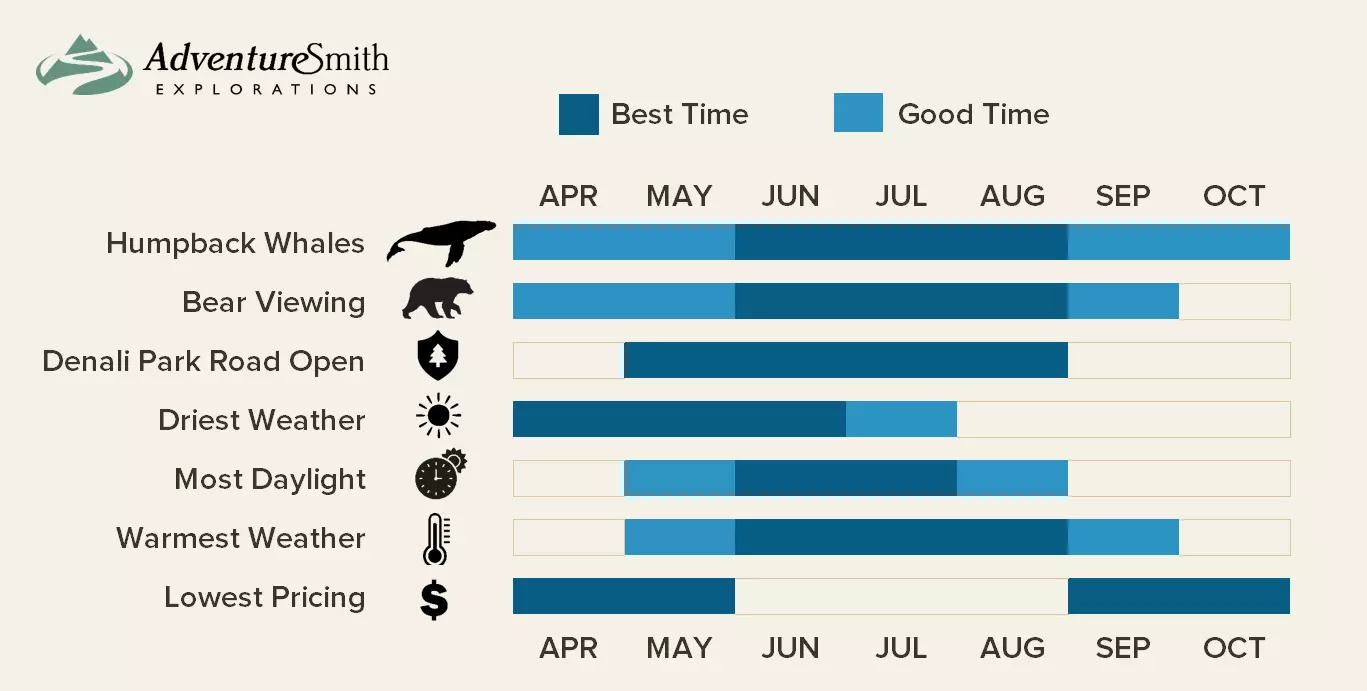
April in Alaska
Small Alaska cruise ships begin plying Alaskan waters as early as mid-March, with most early spring departures running regularly starting in mid-April. Early spring offerings center on Alaska Inside Passage cruise itineraries, with most spanning a week. During this time, you can also consider a longer cruise, traveling with small ships positioning from Seattle, Washington up to Alaska. Nights are still long enough to possibly see the northern lights, while days are getting longer and animals are beginning to stir. The annual early spring Pacific herring migration makes for optimal wildlife viewing opportunities, as humpback whales and orca seek out the abundant fish. Hungry bears awake from hibernation and also go looking for food. Snowcapped peaks drive mountain goats and other creatures to the shoreline to forage. And waterfalls are copious as they gush down fjord walls.
Alaska Weather in April:
- Coastal temperature in Alaska in April: 30-45 degrees & 11 hours of daylight
- Interior temperature in Alaska in April: 15-40 degrees & 14 hours of daylight
- Arctic temperature in Alaska in April: -10-5 degrees & 16 hours of daylight
Benefits of Alaska Travel in April:
- Travelers in April and early spring will find lower prices & Alaska travel deals
- April & early spring have Alaska to themselves with non-existent crowds
- Increased offerings for themed cruises & onboard special guests
- Longer northbound positioning cruises from Seattle to Alaska
- Dark nights may show northern lights
Emerging Alaska Wildlife in April:
- Water: Steller sea lions, orca, humpback whales, herring
- Birds: chickadees, wrens, jays, grouse, thrushes, ducks, loons, swans, geese, owls, bald eagles
- Land: mountain goats, brown & black bears
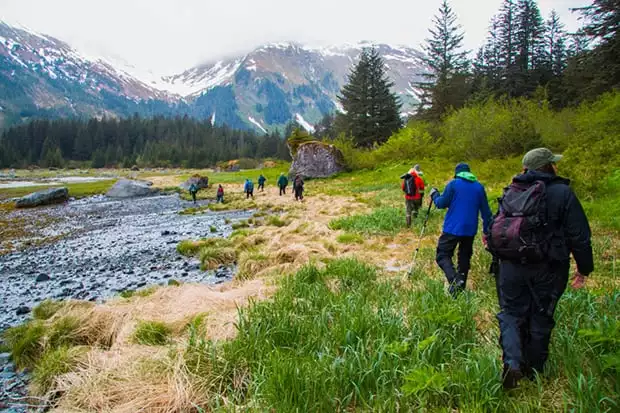
May in Alaska
May is considered Alaska’s spring and early shoulder season. Many small ship cruises begin operating, but with kids in school, you can still feel like Alaska is all yours. The Inside Passage remains the focus as many more cruise departures start in earnest, as well as opportunities for longer sailings from Seattle to Alaska, passing British Columbia along the way. May is one of the driest months and an optimal one to view wildlife awakening, with lots of babies being born, spring migrations ramping up, snow melting and the landscape budding. Land tours are beginning but National Parks in Alaska’s interior are still closed. Mid-month, the shops and attractions also return to life after a winter slumber.
Alaska Weather in May:
- Coastal temperature in Alaska in May: 40-55 degrees & 16 hours of daylight
- Interior temperature in Alaska in May: 30-55 degrees & 18 hours of daylight
- Arctic temperature in Alaska in May: 15-24 degrees & 22 hours of daylight
Benefits of Alaska Travel in May:
- On average the month of May has the least amount of rain
- Travelers in May will find lower prices and Alaska travel deals
- May has fewer tourist crowds than the prime summer months
- May offers longer northbound positioning cruises from Seattle to Alaska
Emerging Alaska Wildlife in May:
- Water: gray whales, harbor seals
- Birds: migratory songbirds & pelagic seabirds arriving on coast
- Land: Dall sheep, moose, wolves, lynx
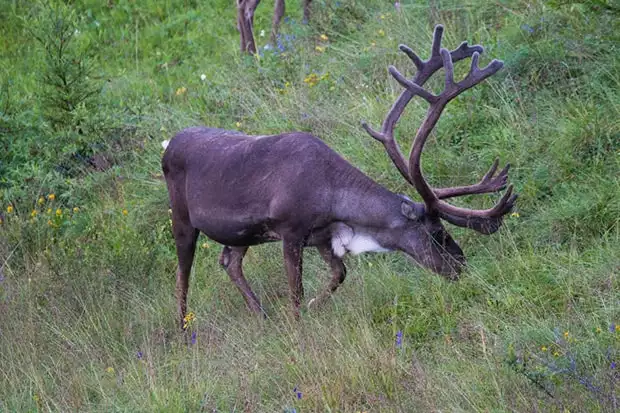
June in Alaska
June is when the Alaska travel season comes into full swing, especially in the latter part of the month, and marks the beginning of the best time to visit Alaska. Glacier Bay cruises are in full swing. Cruises in the Southcentral and Southwestern part of the state begin operating, offering adventures along Prince William Sound, Kodiak Island, Katmai National Park and the Aleutian Islands. Some departures even focus on the Arctic waters of the Bering Sea, bringing guests ashore at various points along Russia’s Siberian coastline—you might even spot a polar bear on Wrangel Island.
June is the month to begin taking land trips in Alaska. The Denali National Park road opens (learn more about visiting Denali National Park); bear viewing in Katmai is optimal with various salmon runs underway; the Kenai peninsula (including Kenai Fjords National Park) is lush with greenery; and the weather is more reliable for flightseeing, floatplane rides, scenic Alaska railroad trips and other special modes of transit for reaching remote wilderness lodges.
Alaska Weather in June:
- Coastal temperature in Alaska in June: 40-60 degrees & 18 hours of daylight
- Interior temperature in Alaska in June: 50-70 degrees & 20 hours of daylight
- Arctic temperature in Alaska in June: 29-38 degrees & nearly 24 hours of daylight
Benefits of Alaska Travel in June:
- Longest daylight hours make active wildlife & ample time for exploration
- Denali National Park & other interior parks open
- Popular towns such as Juneau, Sitka, Anchorage & Fairbanks are in full swing
- Opportunities for cruise & land tour combinations begin
- Wildlife is active with opportunities to view young animals
- Melted snow enables higher altitude hikes
Emerging Alaska Wildlife in June:
- Water: harbor seal pups, ducks hatching, beluga whales
- Birds: optimal seabird & alpine bird rookery viewing
- Land: caribou, mountain goat kids, black bear cubs, moose calves
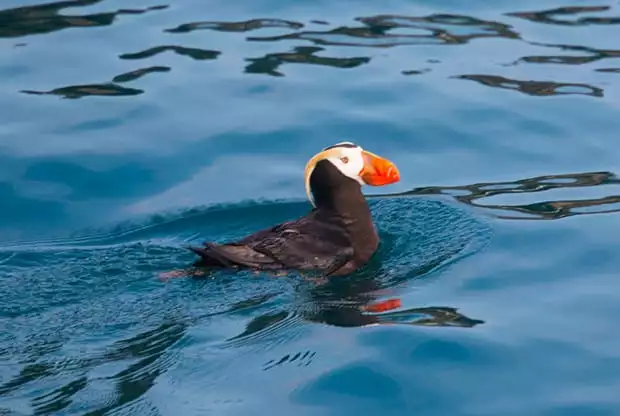
July in Alaska
For many people, the answer to the question “When is the best time to go to Alaska?” is July. With wildlife fully active, all trails accessible, long days and Alaska’s warmest average temperatures, July can be the best month to visit Alaska. This translates into a busy time for The Great Land, with a swell of visitors. Small ship cruises during this busy month mean you can still enjoy areas inaccessible to the large cruise ships, such as Kake and Wrangell Narrows; plus, weather won’t affect your ability to access key Alaskan cities like Sitka. Land tours, averaging 5-8 days, set you up to thoroughly enjoy some of Alaska’s best national parks during this ideal month. If you are planning travel to Alaska in July, then plan ahead and book early.
Alaska Weather in July:
- Coastal temperature in Alaska in July: 50-65 degrees & 18 hours of daylight
- Interior temperature in Alaska in July: 50-70 degrees & 19 hours of daylight
- Arctic temperature in Alaska in July: 33-45 degrees & nearly 24 hours of daylight
Benefits of Alaska Travel in July:
- Opportunities for cruise & land tour combinations continue
- Long daylight hours make active wildlife & ample time for exploration
- Alaska’s warmest temperatures of the year occur in July
- Spawning salmon means ideal fishing
Must-See Alaska Wildlife in July:
- Water: prime month for humpback whales, salmon runs, sea otters
- Birds: puffins, shorebirds begin migrating (millions of birds possible in a flock)
- Land: black & brown bears (including grizzlies); mountain goats
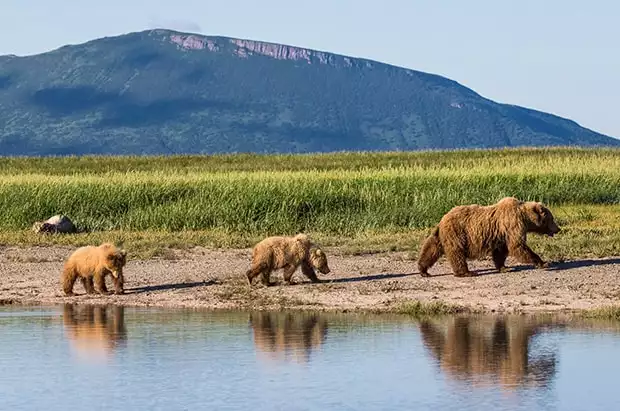
August in Alaska
August is a popular time to visit Alaska and marks the end of the high travel season. Increased moisture improves the vibrancy of an already verdant landscape. Midway through August, colder temperatures encourage brilliant fall foliage, especially in the interior and Denali National Park. Wildlife remains in abundance and all Alaska small ship cruises and Alaska tours are operating on a regular basis. As the month winds down, so do the number of travelers to Alaska, with a shift in weather that signals fall has arrived.
Alaska Weather in August:
- Coastal temperature in Alaska in August: 50-60 degrees & 18 hours of daylight
- Interior temperature in Alaska in August: 45-65 degrees & 18 hours of daylight
- Arctic temperature in Alaska in August: 33-41 degrees & 20 hours of daylight
Benefits of Alaska Travel in August:
- Cruise & land tour combinations
- Long daylight hours make active wildlife & ample time for exploration
- Ideal fishing conditions (halibut, rainbow trout, northern pike, salmon)
Must-See Alaska Wildlife in August:
- Water: beavers, humpback whales & orca,
- Birds: peak songbird migration, bald eagles, loons
- Land: caribou, black & brown bears (including grizzlies)
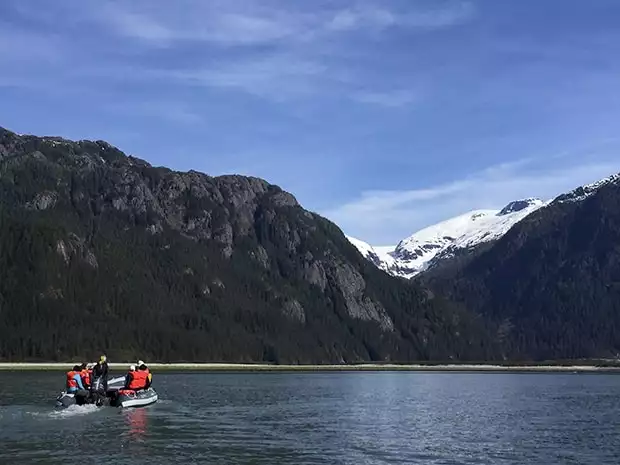
September in Alaska
September brings Alaska’s fall shoulder season, with fewer visitors and often Alaska special offers. Longer nights again bring possible opportunities to view the aurora borealis. The cooler weather turns trees and tundra into explosive fall colors of red, gold and purple. Snow begins to dust mountain peaks. Animals are busy preparing for the oncoming winter—migrating, mating, marking territory, hunting and foraging for food—which increases your odds of viewing all manner of wildlife. September marks the end of the Alaska travel season and is the best time to travel to Alaska for low prices and Alaska travel deals.
Alaska Weather in September:
- Coastal temperature in Alaska in September: 40-55 degrees & 15 hours of daylight
- Interior temperature in Alaska in September: 35-55 degrees & 17 hours of daylight
- Arctic temperature in Alaska in September: 28-33 degrees & 14 hours of daylight
Benefits of Alaska Travel in September:
- Travelers in September will find lower prices & Alaska travel deals
- September has fewer tourist crowds than the prime summer months
- September offers longer southbound positioning cruises from Alaska to Seattle
Alaska Must-See Wildlife in September:
- Water: gray whales, harbor seals, sea lions
- Birds: gulls & raptors begin migrating, bald eagles, black oystercatchers
- Land: elk, moose, caribou, deer
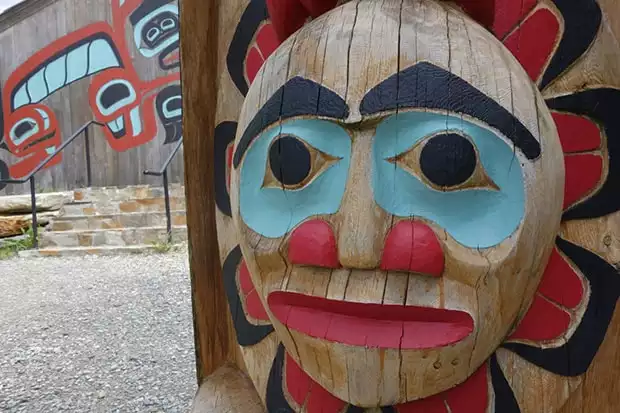
October & November in Alaska
Late fall in Alaska is not known for cruises and land tours. Weather is wet and increasingly cold. Alaskan wildlife and Alaskan residents are preparing for the cold dark winter to come. Specialty tours and fishing can attract hearty travelers and custom tours can be arranged.
Winter in Alaska—December Through March
Winters in Alaska can be harsh and beautiful. Weather is extremely cold and storms are severe. Winter activities such as dog sledding, snow shoeing and skiing are possible. A popular attraction during Alaska’s winter is viewing the northern lights (aurora borealis). Specialty lodges offer comfortable accommodations for hearty travelers willing to brave cold long nights to witness this spectacle of nature. What’s the best time to cruise Alaska to see the northern lights? Look to our dedicated page on northern lights cruises for tips and best places to spot the aurora.
Best Time to Cruise Alaska
The Alaska cruising season begins in March and ends in October. The peak season with best weather and wildlife occurs during summer months. It’s then that travelers will find the best combination of long days, good weather and abundant wildlife, including greater numbers of whales that congregate in predictable feeding pods putting on quite a show. But spring, when Alaska awakens from a long winter, is also another favorite time to cruise Alaska. Snow is present in the mountains, driving hungry bears down to the coast for a meal. Small ships, which can sail close to the shore, take advantage of these springtime encounters. April and May are the driest months along Alaska’s coast and there are fewer crowds in both town and on the water. You will find the best prices of the year on small boat tours of Alaska as well at this time.
As Alaska small ship cruise experts, we advise clients that the best time to cruise Alaska is May 15 through September 1. If we had to choose one, the best month for an Alaska cruise is July.
Typically, there are no scheduled cruises from mid-October through February, but special Alaska charter cruises can be arranged during this time with advanced notice. Families typically visit mid June through mid August. View the best Alaska cruises for families. See our monthly Alaska weather tips and travel advice above to find your best time to take an Alaskan cruise.
Best Time to Travel to Alaska by Land
Alaska’s interior is colder than the coast so the land-based travel season can be shorter than the cruising season. Keep this in mind if you are planning an Alaska small ship cruise and an Alaska land tour combination.
Summer in interior Alaska is short and occurs from mid-June through late-August. Winter in Alaska sees far fewer travelers with December through March being the best months to view the northern lights. The spring and fall months in Alaska offer unique opportunities and lower prices.
In our opinion the best time to travel to Alaska is in June, July and August. The best month to visit Alaska is July, when travelers will experience the best combination of weather and wildlife. See our breakdown of Alaska weather by month above to learn more about the temperatures, sunlight and wildlife, to find the best time to visit Alaska for you.
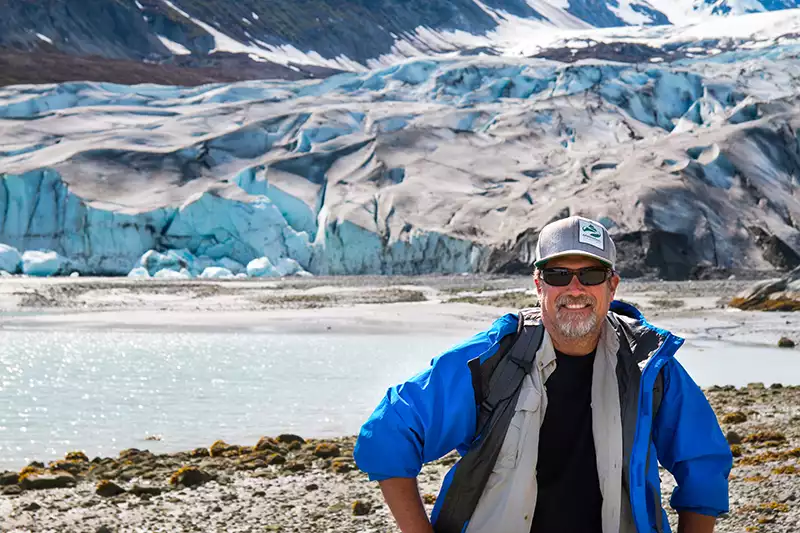
CONNECT WITH AN
ALASKA SPECIALIST
You have questions. We have answers.
Alaska Whale Watching Season
Whales can be seen from small ships to Alaska throughout the small ship cruise season of May through September. Orca and minke whales are residents so they may be found at any time of year. But most travelers want to see humpbacks and if you fall into this category, then you must plan your trip accordingly.
When to see humpback whales in Alaska? The first humpbacks begin to arrive in Alaska about late April and early May. These are typically the adult males that can make the long migration the fastest. They are followed by younger males, females and finally mothers with calves arriving in late May and early June. Small ship cruises in May will likely view whales, but they will be individuals or smaller groups of two or three spread about looking and waiting for food.
When is the best time to see whales in Alaska? The best time to cruise Alaska for whales is from mid-June through mid-August.
By mid-June most humpbacks have arrived and they are gathering together in predictable feeding pods. This is the best time for whale watching in Alaska and the consistent sightings will continue through mid-August when the first whales will begin to leave for warmer waters. During this best time to see humpback whales in Alaska, sightings are almost guaranteed.
Why is mid-June through mid-August on an Alaskan cruise the best time to see whales? Sunlight from long midsummer Alaskan days causes a bloom of phytoplankton (tiny plants) which serves as the base of Alaska’s rich marine food chain. Strong currents bring nutrients from deep below to mix with oxygen-rich water near the surface resulting in huge blooms of zooplankton (tiny animals), krill and small fish such as capelin, candlefish and herring.
For more insights into seeing whales on your expedition cruise, including tips on where to spot whales, how to prepare and the advantages offered by small ships, read our primer on whale watching in Alaska.
Alaska Mosquito Season
Mosquitoes, sometimes jokingly referred to as the Alaskan state bird, are a fact of life during the summer travel season. But they are more annoyance than deterrent so don’t let bugs affect your travel plans. Mosquitoes and other bugs are most prevalent in the boggy interior and Arctic tundra regions during mid-summer. Populations spike in late June and dissipate in early August. They can’t fly in a light breeze and they aren’t as active in rain, which keeps coastal and mountainous regions relatively bug-free.
You will not encounter bugs on small ship cruises, except when venturing ashore on calm days and even then, they are seldom troublesome. Your packing list should recommend remedies to repel bugs and long-sleeve clothing to keep them at bay when they are encountered. Being equipped for weather and conditions will make your Alaskan experience more enjoyable.
Weather & Packing for Alaska Travel
Weather in various Alaska destinations is unpredictable and travelers should prepare themselves for a range of conditions, no matter what month you travel. We have developed comprehensive Alaska planning guides for our booked clients, with expertise culled from years of our own living, working, guiding and traveling in Alaska.
Prepare for a range of conditions, no matter what month you travel.
Layers are essential for a comfortable Alaska vacation, using fast-drying wicking materials. A raincoat and rain pants are also must-haves, as is a warm hat and gloves. Many boats and some lodges will provide rubber boots. With a well-packed bag, you can appreciate the opportunities created by varying weather, which in turn creates the cornucopia of landscapes and wildlife that brings travelers to the Last Frontier.
Checking the Weather Before Your Trip
Many travelers incessantly check the daily weather in Alaska as their trip approaches. We advise you to resist this temptation, it will only drive you crazy. Local forecasts in Alaska are astoundingly inaccurate and weather changes by the hour. Checking daily forecasts does little to help you prepare.
Stick to the broad guidelines above and as previously stated, follow the advice of your packing lists. Checking the weather before your Alaska trip will only serve to frustrate your preparations and offers little insight into what conditions will be like when you arrive.
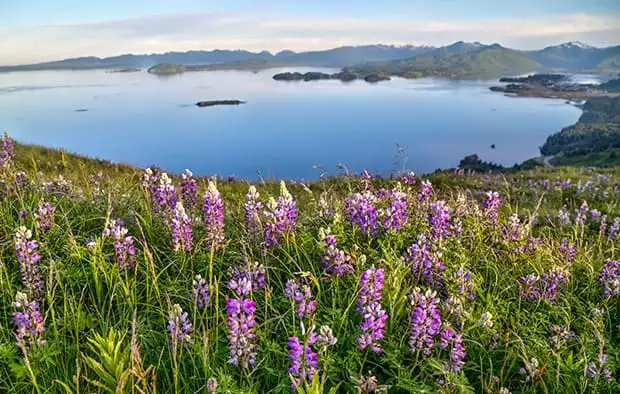
Timing & Latitude in Alaska
While this Alaska by Month guide is a valuable resource for planning when to go, wildlife and weather can never be fully predicted, especially in a land as powerful as Alaska. Life in Alaska is greatly affected by latitude variances, as slight latitude shifts can result in big seasonal and light changes. The nature of small ship cruising is to be flexible and nimble, and this ethos should be applied to any trip in Alaska, by land or sea. After all, the surprise in what you experience while in Alaska is a big part of the fun.
Alaska Climate Tables
Use the Alaska climate and weather tables below to determine the average temperature, rainfall and daylight. Learn more about Alaska’s climate and find the best month to visit Alaska.
Averages by Location
Anchorage, Alaska
| Month | Jan | Feb | Mar | Apr | May | Jun | Jul | Aug | Sep | Oct | Nov | Dec |
|---|---|---|---|---|---|---|---|---|---|---|---|---|
| Avg. High (F) | 22 | 26 | 33 | 44 | 55 | 62 | 65 | 63 | 55 | 40 | 28 | 22 |
| Avg. Low (F) | 9 | 12 | 17 | 28 | 39 | 47 | 52 | 49 | 41 | 58 | 16 | 10 |
| Avg. Rain |
0.7 | 0.8 | 0.6 | 0.5 | 0.7 | 1.0 | 1.9 | 2.7 | 2.6 | 1.9 | 1.0 | 1.1 |
| Avg. Day |
5.5 | 7.5 | 10 | 13 | 17 | 19 | 19 | 17 | 14 | 11.5 | 8.5 | 6 |
Juneau, Alaska
| Month | Jan | Feb | Mar | Apr | May | Jun | Jul | Aug | Sep | Oct | Nov | Dec |
|---|---|---|---|---|---|---|---|---|---|---|---|---|
| Avg. High (F) | 30 | 34 | 39 | 47 | 55 | 62 | 64 | 63 | 56 | 47 | 38 | 33 |
| Avg. Low (F) | 19 | 23 | 27 | 32 | 39 | 45 | 48 | 48 | 43 | 37 | 29 | 24 |
| Avg. Rain |
4.3 | 4.0 | 3.4 | 2.9 | 3.5 | 3.1 | 4.4 | 5.4 | 7.2 | 7.9 | 5.4 | 5.1 |
| Avg. Day |
6.5 | 8 | 10.5 | 13 | 16 | 18 | 18 | 16.5 | 14 | 11.5 | 9 | 7 |
Denali National Park
| Month | Jan | Feb | Mar | Apr | May | Jun | Jul | Aug | Sep | Oct | Nov | Dec |
|---|---|---|---|---|---|---|---|---|---|---|---|---|
| Avg. High (F) | 10 | 16 | 25 | 39 | 53 | 64 | 66 | 61 | 51 | 32 | 18 | 11 |
| Avg. Low (F) | -1 | -5 | 1 | 15 | 29 | 39 | 43 | 38 | 31 | 14 | 1 | -6 |
| Avg. Rain |
4.3 | 4.0 | 3.4 | 2.9 | 3.5 | 3.1 | 4.4 | 5.4 | 7.2 | 7.9 | 5.4 | 5.1 |
| Avg. Day |
7 | 9 | 12 | 14.5 | 17.5 | 19 | 17 | 14 | 11.5 | 10 | 7 | 6 |
Learn more about the best time to visit Denali.
Arctic Alaska
| Month | Jan | Feb | Mar | Apr | May | Jun | Jul | Aug | Sep | Oct | Nov | Dec |
|---|---|---|---|---|---|---|---|---|---|---|---|---|
| Avg. High (F) | -8 | -12 | -10 | 5 | 24 | 38 | 45 | 41 | 33 | 18 | 4 | -4 |
| Avg. Low (F) | -19 | -22 | -20 | -10 | 15 | 29 | 33 | 33 | 28 | 9 | -7 | -17 |
| Avg. Day |
4 | 8 | 12 | 16 | 22 | 24 | 24 | 20 | 14 | 10 | 4 | 2 |
So, When is the Best Time to Visit Alaska?
Considering everything stated above, we advise travelers that June 15 through August 15 is the best time to go to Alaska. But not everyone can schedule their trip during this time and as we’ve noted, each season has its benefits. If you plan your trip during the peak season, then plan ahead and book early as these are the dates that sell out first.
If you like this guide to the best time to visit Alaska, you’ll love our comprehensive travel planning services. Our experts have more information on when to visit Alaska, planning your Alaska trip or the best time of year to visit Alaska. When you are ready to book the trip of a lifetime, just give us a call, our experts are ready to help.
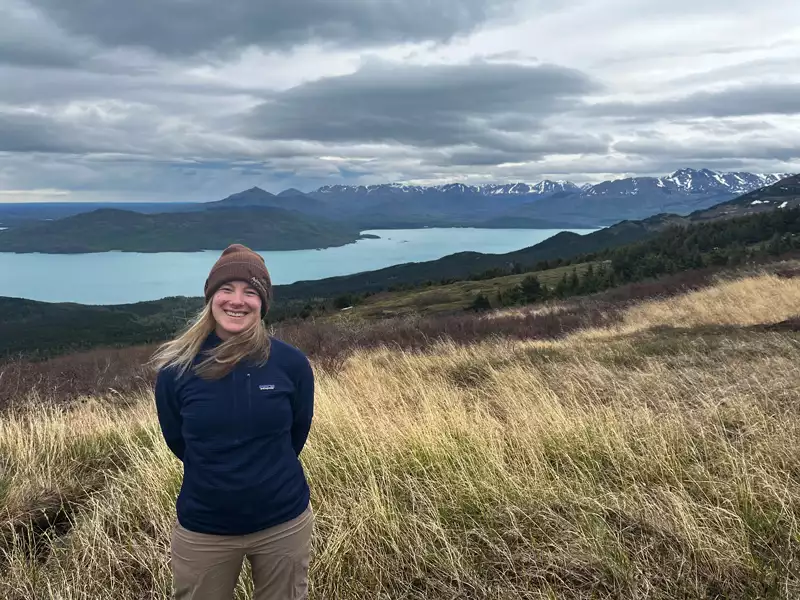
BOOK YOUR ALASKA TRAVEL
1-on-1 consultation.
Start planning today.
MORE ALASKA RESOURCES:
Alaska Trips
Alaska Trip Reviews
Alaska Travel Guide
Alaska Small Ship Cruises
Alaska Big Ship vs Small Ship
Small Alaskan Cruise Lines
Glacier Bay Cruises & Tours
Alaska Inside Passage Cruises
Alaska Whale Watching Cruises
Alaska Yacht Charters
Luxury Alaska Cruises
Alaska Family Cruises
Alaska Cruise Deals
Alaska Tours
Visiting Denali National Park
Alaska National Park Tours
Have a question or looking for advice about the best time to visit Alaska? Use the comments below and we’ll answer your questions about the best time to travel to Alaska. Ready to plan and book your Alaska with our experts? Contact us.
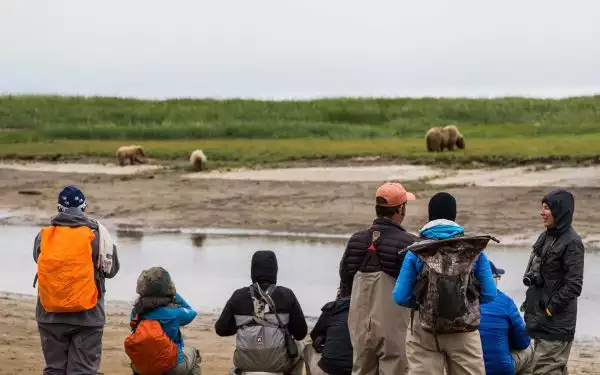
Comments will be moderated and will appear after they have been approved.
My husband and I will be traveling in a 30’ motorhome and are leaving Pennsylvania and visiting friends in Nebraska. We wondered if after Labor Day is a good time to head up to Alaska. We’ve never been there before and wondered about campgrounds or areas we can stop for the night. We are not towing a car and haven’t really thought about where to go yet. Any ideas ?
Pat
Pat,
It sounds like you have an exciting adventure ahead of you! While our specialty is planning and booking small ship cruises and wilderness adventures, we are happy to share some resources to help plan your road trip. First, you will surely want to learn more about how to visit Denali National Park. The Milepost can get you started with routes, major attractions and how to transit the Alaska Highway. In addition to our info on Alaska weather in September, the State of Alaska travel site is great for timing and weather during Labor Day. We believe that getting away from the roads and rails is essential to any authentic Alaska trip, so if you are interested in experiencing the real Alaska, please contact us for further assistance.
My husband and I want to see the Northern Lights. What month is best for clear skies and best viewing. We wanted to go in March but the Borealis Basecamp is already booked. Is April a good month. or is the snow already melting which would hamper dog sledding? Is February too cold?
Hi Vicki, thanks for your question.
April is on the tail end of Alaska’s aurora season. If your ultimate goal is to see the lights, going earlier in winter is the best time. February can be quite cold, but it often brings dark clear skies, ideal for seeing the Aurora. If you’re flexible with dates, late February to early March might be a good compromise. There are a number of other remote lodges and tours out of Fairbanks that you may enjoy. Contact us directly to speak with a specialist who can check availability and craft a custom Northern Lights vacation that’s right for you.
Hi, my birthday is at the end of October, and I want to see the northern lights, is October a good time to see the northern lights and what’s the best place?
Hi George,
In Alaska, viewing the Northern Lights is possible in October. Typically, there are no scheduled small ship cruises from mid-October through February, so traveling inland for a tour in Fairbanks and areas more north are your best bet in this region. We offer custom tours in Alaska and can offer October recommendations that fit your goal.
For the ultimate birthday celebration, head to the Arctic for the Northern Lights. Our northern lights cruises in Greenland and Iceland are focused in October for best chances of witnessing.
Hello,
This was very informative. My friends & I are cruising to Alaska June 4-16,2024. Our first time and my bucket list. I’m hoping to have the trip of a lifetime. I’ve been trying to come see Alaska for 40+ years. I’ve watched the commercials on TV and know it’s going to be amazing. Can’t wait. Can you help me with packing? How much & what?
Thanks so very much.
Janis A. Jones
Coming from Maryland by way of California
Thank you Janis, and congratulations on your upcoming trip to Alaska! It will be well worth the wait. We recommend packing a variety of versatile attire and clothing layers to accommodate the unpredictable Alaskan weather. Besides our firsthand expertise, another one of the many benefits of using a travel specialist is access to our comprehensive Alaska trip planning materials. As you continue your preparations, reach out directly to your cruise operator for any packing resources they may offer. Have an unforgettable trip and keep us in mind for future small ship cruises worldwide.
Cruise in September 20-27. Never been to Alaska I really didn’t want to over pack, any suggestions?
Hi Tammy,
What an exciting trip to look forward to. You can read more about Alaska in September plus advice on packing layers, rain gear and more in the Alaska Weather & Packing sections above. Or learn about Alaska’s climate and how greatly the weather is affected by latitude variances. Our comprehensive Alaska trip planning materials are written by our experts with decades of combined experience and provided to our clients at the time of booking. The best thing to do is contact your cruise operator directly and request their packing resources. Have an incredible cruise and please talk to our experts when planning your next small ship cruise vacation.
I am taking a cruise by Norwegian cruise line and I was wondering when is the best time to come to see all the sites my friend wants to see the northern lights if possible can you tell me when to come? I appreciate it. Thank you very much.
Hi Mike,
The best time to see aurora borealis in Alaska is during the winter, but the cruise options during that time are slim. To better your chances of seeing the northern lights via Alaska cruise, search for trips with departures as early or late in the cruising season as possible: typically March or late September or October. Learn more about Alaska northern lights cruises on our dedicated northern lights cruises page. Have a great trip.
Will I need a heavy coat in september
Hi Esther, thanks for your question.
During September in Alaska temperatures and conditions vary across regions. At the beginning of the month, you’ll likely have fall-like conditions, but it is a short fall. As the month progresses temperatures drop. By late September you will want thicker clothes and a winter jacket. It can also be colder at higher elevations, on a boat, and during morning and evening hours. Layering is essential, so we always recommend inner layers with a combination of a fleece layer then waterproof layer you can remove.
Alaska is on by my bucket list, for one reason is the northern lights, I want to see as much as possible when I come. Either by plane, train, boat, or bus. I may never get but one trip so when should I come or do you have any suggestions?
Thanks for your question, Denise. The best time to go to Alaska really depends on your focus. For prime Northern Lights viewing you should visit during the dark winter nights from November through March. If you want a well-rounded winter trip, visit a specialty lodge for Northern Lights. For the best Northern Lights cruises, consider instead traveling to the Arctic.
But to get the most out of your Alaska trip with great weather, wildlife, longer daylight hours, and have the potential for Northern Lights, you could take an Alaska small ship cruise in the fall, then continue north to Fairbanks, where the Northern Lights begin showing themselves in late August and early September. We offer custom crafted tours in Alaska so contact us if you are interested in speaking with an Adventure Specialist.
I loved all of the info on this post. Thank you. This will make my preparations more accurate. Knowing the weather, daylight hours and wildlife information is a tremendous help.
Glad we could be of assistance, Sherri! Our experts have lived, worked and explored Alaska during every season. Have a wonderful time on your trip in Alaska! If you need further trip planning assistance don’t hesitate to contact us.
I am planning an economic run in my Mitsubishi Mirage to see as much of alaska as possible by car. I’ll be planning late September as I wish to see the northern lights as well during this trip. Trip starts in Texas, my home state. Will the roads be passable around that time for small front wheele drive cars, or should I plan this in early August?
Hi Royce,
What a long and exciting trip! Weather can be very unpredictable year-to-year in the fall in Alaska, and services associated with the busy summer tourism season will be winding down. We’d recommend contacting a AAA chapter in Alaska to get some more road-trip guidance. Our expertise is in guided trips and small ship cruises, so for travelers wanting to take in aurora borealis on a ship, we recommend our Arctic-based Northern Lights cruises.
This has been very informative as I want to plan a trip to Alaska. I want to be able to visit the Glaciers, National Parks as well as the Arctic Area.
Wow Gail that sounds like quite the comprehensive Alaska trip! If you need help crafting the itinerary, please contact our experts. AdventureSmith Explorations specializes in creating custom travel by land or sea and will suggest draft itineraries with Alaska lodging or small cruise ship that meet your needs and budget.
This post was very helpful because I’m planning a trip to Alaska in August.
How exciting! August is a popular time to visit Alaska. Wildlife is abundant, the days are long and the weather is warm and wet. If our experts can further help you choose an Alaska small ship cruise or Alaska tour please do contact us.
Can’t wait to travel to Alaska this coming August
You’re in for a real treat, Barbie! August in Alaska is a great time to see humpback whales, orcas, bears and other wildlife as they capitalize on salmon runs. Have a great time.
Hi, I’m a senior with limited walking. I’m hoping to take a cruise the beginning of August. Will I enjoy cruising without a lot of side excursions. Thank you
Hi Patty,
There is an Alaska small ship cruise for every style of travel from active to relaxed. Many travelers remain on board to enjoy scenic wilderness cruising from the ship. Travelers with limited mobility may also seek a small ship with an elevator to make moving around the boat easier. Consider Exploring Alaska’s Coastal Wilderness aboard the 100 guest National Geographic Quest or Venture. Small ships cruise close to shore where bears, moose, eagles, and wildlife are easily spotted (bring your binoculars). Flexible itineraries mean small ships can stop and linger longer when whales are spotted. Contact our experts for a full consultation on your perfect Alaska trip and small ship.
Would like to know if someone can tell me weather in April I’m riding my motorcycle Plan is to start Fron SD CA to Prudhoe Bay and back down To SD /camping and also motel.
I’m researching and I’m a little confuse any help is appreciated
Thanks for your comment and what an adventure! We once had a group of clients ride their motorcycles all the way from Florida to embark one of our smalls ship cruises in Alaska. While our specialty is planning and booking small ship cruises and wilderness adventures, here are some resources to help with your trip. The post above has an overview of the wildlife and weather in Alaska in April. Find more detailed Alaska climate information with temperature, rainfall and daylight tables. You will surely want to learn more about how to visit Denali National Park.
Getting to Alaska will require a transit of the Alaska Highway and The Milepost is a good resource for travelers traveling by road. Finally, the State of Alaska travel site can be a good resource for Alaska weather. We believe that getting away from the roads and rails is essential to any authentic Alaska trip, so if you interested in getting off your bike to experience the real Alaska, please contact us.
We want to visit Alaska July 21- 30 for my daughter birthday. Tips on what to do are highly appreciated.
Thanks Miros, you’ve come to the right place! Our team of true Alaska experts can craft the perfect birthday trip suited to your interests, ability and budget—by land, sea or both. Space is quickly becoming limited for July 2022 so we recommend booking soon. An Alaska expert will be in touch.
Hi we are doing a cruise the end of august. I am trying to figure out how to pack. We have gone in July and it was extremely hot, then we went the next year about the same time and it was extremely cold. Like to know what the weather is like the end of august
Hi Robin,
Here is the section on Alaska in August. It sounds like you’ve experienced how unpredictable Alaska’s weather can be firsthand, so you’ve got a leg up on packing. Our advice is to always prepare for a range of conditions, no matter what month you travel to Alaska. Read more advice on packing layers, rain gear and more in the Alaska Weather & Packing section above. Or learn about Alaska’s climate and how greatly the weather is affected by latitude variances. Weather can never be fully predicted but reach out directly to your cruise operator for packing materials, they may supply comprehensive Alaska planning guides like we do for our booked clients. Have a great time!
Scheduled for a cruise to Alaska June 11-18 2022. Wanted to find out how to dress. I live in Hawaii & it’s summer we use summer clothes that time if the year & ha ha most year ‘round.
We are thrilled you get to experience Alaska this summer. Our comprehensive Alaska trip planning materials are written by our experts with decades of combined experience and provided to our clients at the time of booking. The best thing to do is contact your cruise operator directly and request their packing resources. Have an incredible cruise and please talk to our experts when planning your next small ship cruise vacation.
My name is Sonya, and I really want to be brave and travel to Anchorage and other parts of Alaska in mid February,2022. Are there many things to see and do at that time or would you recommend another time? I was really hoping to see the Northern lights if possible. Please help guide my decision. Thanks in advance for the advice.
Hi Sonya and thanks for your question.
While the northern lights (sometimes called aurora borealis) occur year round in Alaska the best time to view them are dark nights November through March. February is cold and clear, making it an excellent time for northern lights viewing. March is also nice with dark nights but a bit more daylight. We’d recommend getting farther north to Fairbanks and away from the city lights for the best aurora viewing. Stay up late as the best viewing is from 10am-3am. Some lodges can arrange for a wake-up call if/when the lights do come out. If you plan on spending 5-7 days in Alaska with a least 3 nights looking for the lights you’ll have a 90% of seeing them. Remember the lights need to be out and you need clear skies. The aurora can be elusive so think of it as an adventure. But the payoff is one of the most incredible spectacles of nature. Finally you can check the aurora forecast from the University of Alaska Fairbanks. There are a host of winter activities available such as the Alaska Railroad, hot springs, dog sledding, snowmobiling, skiing and snowshoeing. We offer custom crafted winter tours in Alaska so contact us if you are interested in speaking with an Adventure Specialist.
We want to travel summer 2022, fly into Anchorage and travel north and south from there. I’m concerned about it raining if we come in late July into August. Does it rain constantly, or do you have brief showers like Hawaii?
Hey Karen! “Unpredictable” best describes Alaska’s weather. Throughout the summer, weather is variable and can change rapidly. Alaska is a rainy destination, so you are likely to encounter rain at some point during your trip no matter what summer month you choose. In Anchorage and Denali rain showers and the chance of storms, with more than just showers, increase as the summer progresses. See the above Alaska climate tables for rainfall by month.
Our clients are prepared with an extensive packing lists and travel preparation. Pack the right gear, prepare for rain and if you get lots of sunshine, it’s a bonus! May and June are considered the “driest”, but even then there’s always a chance of rain on any given day. Feel free to contact our Alaska travel experts for further assistance. They have lived, worked and explored the region in depth as former guides, operations managers and naturalists, and can help you craft the perfect Alaska package.
Hello, and thank you for this wonderful information. My husband and I would like to fly in from Arizona. We are not big into city life, noise pollution, bright lights and lots of people. We love nature and I am a photographer. We love the fall and moderate hikes. Where would you suggest we fly into, as well the areas of beautiful Alaska, that you would suggest, based on our interest.
Hi Nancy,
I’m glad our post helped you decide that fall is the best time to visit Alaska. Our full-service trips showcase the best of Alaska, with plenty of nature, hiking and photography opportunities (as evidenced by our small ship Alaska cruise reviews and Alaska tour reviews). Fly into Juneau, Sitka, Ketchikan or Petersburg for Southeastern Alaska’s Inside Passage. And fly into Anchorage to access Prince William Sound, Denali/Katmai/Kenai Fjords National Parks and Kodiak Island. To help narrow your options, consider our Alaska Cruise Guides (and our picks for 5 iconic Alaska wildlife cruises) and how to visit Denali National Park. An Adventure Specialist will be in touch soon to discuss fall options and better hone in on your ideal trip.
Hello,
I wanted to catch beautiful fall foliage in AK as well. I’m planning to go there in 2nd week of September. Will that be too late for fall foliage? We also would like to check out some national parks as well and definitely wildlife sightseeing and finishing. We also will visit some old friends who live in Dutch Harbor. We will be staying in Airbnb, rent a car to drive around. Should we land in Anchorage airport for our convenience ? We are from Sacramento, California. Please give me some ideal here when go go, should we stay in Anchorage for few days then take off to Dutch Harbor? Please advise. Thank you.
Sincerely,
Yen
Hi Yen! That will be quite the adventure!
The remoteness of Dutch Harbor, part of the Aleutian Islands, fits our hallmark style of small ship cruising perfectly. September is a great time to see Alaska’s fall colors and Anchorage is a perfect central hub to explore from. It offers many ways to enjoy the surrounding national parks plus flight connections to Dutch Harbor. The earlier in September you go the less likely you will have to deal with snow conditions and will have more options for cruises and Denali National Park tours. As a full service tour operator we’re here to help you arrange the seamless vacation of a lifetime experiencing the best of Alaska up close and in style. Contact us to talk about the benefits of our expertise.
We are traveling to Alaska the second week of October 2022. Our only nailed down event is a wedding in Glacier View mid week. We are avid hikers and would love to see the National Parks in any aspect. We will likely rent a car and also looked at winter trains. We thought we’d start in Anchorage, hit Glacier View, Wragnell, Denali, then back to Anchorage. Is this doable?
Hi Emily,
A self-drive trip is do-able in the late fall. Be aware though, that by October 1st Denali National Park begins to wrap things up. Tours, lodges, shuttle buses, Visitor Centers, Ranger Stations and campgrounds are all closed. Because late fall season DIY trips are largely based around weather conditions, we recommend directly contacting the parks you wish to visit in the fall to get an update before traveling to them.
Winter arrives early to interior Alaska so there can be snow on the ground by the end of September or early October. Take a look at our Alaska climate page to see the rainfall averages and daylight hours in October. We focus our Alaska cruises and land services during the primary tourist season from May through August but can help with custom tours during the fall–contact us if you are interested.
Hi, we are planning a trip to Alaska and have specific things we would like to experience.. Northern Lights, wildlife, beautiful color changes would be on the top of our list. We have special travel needs that need to be addressed as well, one wheelchair bound guest and another is 100% service disabled veteran. We also travel with service animals (2 dogs). Do you have any suggestions pertaining to our situation to guide us in our plans? Thanks in advance
Hi Tammy,
Sounds like early fall would be the best time for your Alaska trip. The easiest way to check most of your boxes would be a land viewing rail tour. The Alaska Railroad’s passenger trains are wheelchair accessible and service animals are welcome. From the train you can enjoy Alaska’s fall colors between Anchorage and Denali, stop in Denali for incredible wildlife, then continue north to Fairbanks, where the Northern Lights begin showing themselves in late August and early September. Before the land tour, you could also consider adding a cruise component for even more up-close wildlife opportunities. Fall colors in Alaska last only a few short weeks so timing with Northern lights can be tricky, but with a little luck, Alaska will provide. An Alaska specialist will be in touch soon to discuss Denali-based Alaska tours, potential small ship Alaska cruises, or a custom travel arrangement to cover both.
My husband and i are planning a cruise this coming year. My biggest goal is to see whales. When is the best time for whale watching.
Thank you S.D.
Hi Sharon,
Whale watching aboard an Alaska small ship is a spectacular goal! Our guide to Whale Watching Aboard Small Ship Cruises in Alaska recommends mid-June through mid-August, although whale sightings are possible throughout the season. Most of our small ship Alaska cruises offer opportunities to see whales. One of our Alaska Adventure Specialists will be in touch soon to discuss a trip that best suits your whale watching goals.
Hello,
I want to see the ice caves, but flights in summer are too expensive for me. Can you suggest any other time?
Hi YM,
You’re likely referring to the Mendenhall Glacier out of Juneau, Alaska, which our team has experience visiting, but mostly en route to Alaska small ship cruises or other adventures in the Southeast Alaska region. While we’re not experts on ice caves, and conditions can vary any time of the year, the ice is most likely more stable (but the temperatures still bearable for travel & flights less expensive) in the spring and fall. Contact us to discuss planning and booking an Alaska trip like this further if you wish! Just know that our expertise is in adventure travel packages built for you to see the best of Alaska vs. day trips.
Hello, and thanks for the info.
Do you know what time of year is when mosquitoes are all over?? Or is there any condition when they are not that annoying?
Thanks
Hi Sergio,
Mosquito density in Alaska varies by month and location. On Alaska small ship cruises there is no need to worry about mosquitos, but inland Alaska land tours do experience them, particularly in Denali National Park. To avoid inland mosquitos, travel outside of July and the first half of August. If you’re aiming to combine a land tour with a cruise, however, consider that whales are in abundance during that time. Contact one of our Alaska specialists to help you pinpoint the optimal timing for your Alaska trip.
So I am trying to plan our first trip to Alaska next year – Flying into Anchorage, renting a car and seeing Homer, Seward and Denali. Just can’t decide what is the best month. We were thinking June 4-13, 2020. Is there snow on the mountain peaks still at this time? What do you think would be the best time to visit? We would to see snow covered mountains! 🙂 We’re from Florida (the Panhandle where Hurricane Michael hit last Oct) 🙁
Thank you so much!
Wendy Chambers
Hello Wendy,
As you read in this post, every month offers its benefits and as we know about weather, in Alaska especially, it can be quite unpredictable. Depending where you are in Alaska the snow on the mountains can last through the year, but the earlier in the season the better! If you need any assistance booking, we have incredible Alaska tours, in addition to our small ship cruises, that get you deep into the wilderness of Denali, Kenai and other incredible Alaska destinations. We are so sorry to hear you were hit by the hurricane, we hope for a speedy recovery to you and your community!
Thanks for the well organized post which answers some planning questions on travel in Alaska. It saves me some research time, and serves as a focus to refer to as I weigh the options.
“There is no best time to cruise Alaska. The nature of small ship cruising is to be flexible and nimble, and this ethos should be applied to any trip in Alaska, by land or sea. Afterall, the surprise in what you experience while in Alaska is a big part of the fun.”
I appreciate your summarizing statement, as it confirms for me that booking with adventuresmithexplorations is the right choice!
Hello Eileen,
Thank you so much for your kind words; we are so glad we could be of assistance. Here at AdventureSmith we aim to offer as much helpful information for our readers and travelers so that they can thoroughly enjoy their time off. We look forward to working with you to find your ideal Alaska trip and an Alaska expert will be in touch with you to help you plan your vacation. In the meantime, check out our Alaska Cruise Guides for another helpful resource.